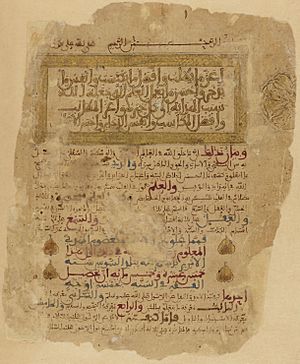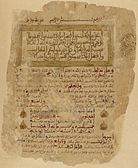Ibn Tumart facts for kids
Quick facts for kids Muhamed Ibn Tumart |
|
|---|---|

An 1183 manuscript of Aʿazzu Mā Yuṭlab, a book of the teachings of Ibn Tumart
|
|
| Religion | Islam |
| Personal | |
| Nationality | Moroccan |
| Born | 1080 Igiliz, Sous, Almoravid Empire |
| Died | c. 1128–1130 Tinmel, High Atlas, Almohad Empire |
| Resting place | Tinmel Mosque |
| Parents |
|
| Senior posting | |
| Title | Imam al-Umma إمام الأمة |
| Influenced | Hafsids |
Abu Abd Allah Amghar Ibn Tumart (Template:Berber language: Amghar ibn Tumert, Arabic: أبو عبد الله امغار ابن تومرت, around 1080–1130 or 1128) was a Muslim Berber scholar, teacher, and political leader. He came from the Sous region in southern Morocco.
Ibn Tumart founded the Almohad movement. This movement was a strict reform group among the Masmuda Berbers of the Atlas Mountains. He became its spiritual and first military leader. In the 1120s, Ibn Tumart started a rebellion against the ruling Almoravids. After his death, his followers, the Almohads, conquered much of North Africa and parts of Spain.
Biography
Who was Ibn Tumart in his early life?
Ibn Tumart was born between 1078 and 1082 in a small village called Igiliz in southern Morocco. He belonged to the Hargha, a Berber tribe. This tribe was part of the large Masmuda tribal group.
His father, Tumart ibn Nitawas, was a lamp-lighter at the mosque. Ibn Tumart was known for being very religious even as a child. People called him Asafu, which means "firebrand" or "lover of light" in Berber. This was because he often lit candles in mosques.
Ibn Tumart claimed to be a descendant of Idriss I. Idriss I was a descendant of Hassan, the grandson of the Islamic prophet Muhammad. At that time, it was common for Berber leaders to claim this special family line to gain religious authority.
What did Ibn Tumart believe and teach?
Around 1106, Ibn Tumart traveled to Qortoba to study. This city was a major learning center under the Almoravids. He then went east to continue his education. There, he was influenced by the ideas of al-Ghazali, a famous scholar.
Ibn Tumart studied with different religious thinkers. He combined their teachings with his own ideas. He also added some Sufi mysticism.
Ibn Tumart's main belief was a strong idea of God's unity (called tawhid). He believed that saying God had separate attributes was like believing in many gods. He thought this was wrong. He also believed the ruling Almoravids had strayed from true Islamic teachings.
He criticized the Maliki school of law, which the Almoravids followed. Ibn Tumart felt they did not follow the Sunnah and Hadith (sayings of Muhammad) enough. He also disliked how relaxed society had become under Almoravid rule. For example, he opposed the public sale of wine and pork.
Ibn Tumart's followers called themselves "al-Muwwahidun". This means "those who affirm the unity of God." This name later became "Almohads" in other languages.
How did Ibn Tumart return to the Maghreb?
After his studies, Ibn Tumart returned to the Maghreb in 1117 or 1118. He traveled by ship and then by land through cities like Tripoli, Mahdia, Tunis, and Bejaia. Along the way, he preached a very strict and simple form of Islam.
He often challenged people to debate. He complained about men and women mixing in public. He also spoke against wine, music, and the custom of men wearing veils while women did not. His strong preaching often got him expelled from towns.
After being forced out of Bejaia, Ibn Tumart settled near Mellala around 1119. Here, he started to gather his first followers. Among them were al-Bashir, who became his main planner, and Abd al-Mu'min, who would later take over from him.
In 1120, Ibn Tumart and his group headed west into Morocco. He went to Fez, a city known for its learning. He debated with scholars there, but they eventually expelled him.
He then traveled south to Marrakesh. Here, he met the Almoravid ruler, Ali ibn Yusuf. Ibn Tumart openly criticized the ruler and his advisors. He said they were not following true Islamic ways. The Almoravid scholars decided Ibn Tumart was dangerous. The ruler ordered him to be punished and expelled from the city.
Ibn Tumart continued his preaching in Aghmat. He destroyed wine jugs and lectured people about their behavior. The authorities tried to arrest him again. But a local chieftain, Ismail Igig, helped him escape. Ibn Tumart then went to the Sous valley to hide among his own people.
What happened at the Cave of Igiliz?
By the end of 1120, Ibn Tumart reached his home village of Igiliz. He went to a nearby mountain cave, much like Prophet Muhammad had done. This made people think he was a holy man.
He began to spread his message of strict reform. He preached in the local Berber language. People were impressed by his powerful speeches.
In late 1121, Ibn Tumart gave a powerful sermon. He announced that he was the true Mahdi. The Mahdi is a divinely guided leader expected to bring justice. His followers immediately accepted him. This was a clear declaration of war against the Almoravid state. To reject the Mahdi was seen as rejecting God.
A powerful chieftain named Omar Hintati was impressed by Ibn Tumart. He invited Ibn Tumart to find safety among the Masmuda tribes in the High Atlas mountains. In 1122, Ibn Tumart left his cave and moved to the High Atlas. This journey became a special pilgrimage route for his followers.
How did the Almohad rebellion begin?
Ibn Tumart called his followers to fight the Almoravids. He wanted to purify the Almoravid state. Around 1122 or 1124, he founded a strong base at Tinmel in the High Atlas mountains. Tinmel became the spiritual and military center of the Almohad rebellion. Here, he wrote books about his teachings for his followers.
Six main Masmuda tribes joined the Almohad rebellion. These included Ibn Tumart's own Hargha tribe. For the next eight years, the Almohads fought a guerrilla war in the mountains. They disrupted Almoravid tax collection and made roads unsafe.
Ibn Tumart's main strategist, al-Bashir, made sure everyone followed the Almohad rules strictly. This led to a period of severe discipline, with many disloyal followers being executed.
What was the Battle of al-Buhayra?
In early 1130, the Almohads launched their first major attack on the Almoravids in the lowlands. They marched towards Marrakesh, the Almoravid capital. They defeated an Almoravid force and then began to besiege Marrakesh.
After forty days, the Almoravids attacked the Almohads. This was the bloody Battle of al-Buhayra. The Almohads suffered huge losses, with 12,000 men from one tribe alone being killed. The Almohads were defeated. A sudden heavy rain helped the remaining Almohads escape back to the mountains.
It is said that after the battle, Ibn Tumart returned to the battlefield at night. He ordered some of his followers to bury themselves with straws to breathe. He then told the other Almohads to ask the "dead" if they were in heaven. When they heard positive replies, their spirits were lifted. To keep the secret, Ibn Tumart reportedly left the buried men to suffocate.
Almohads after Ibn Tumart
Ibn Tumart died in August 1130, just a few months after the terrible defeat at al-Buhayra. Despite this loss and the death of their leader, the Almohad movement did not fall apart. This showed how well Ibn Tumart had organized his group at Tinmel.
Ibn Tumart had created a detailed system for the Almohad community. At the top was his family, along with a special "Council of Ten." This council included his first followers. There was also a larger "Council of Fifty," made up of leaders from the main Masmuda Berber tribes. The Almohad army was also well-organized by tribe.
Who took over after Ibn Tumart?
Ibn Tumart had chosen Abd al-Mu'min as his successor. However, after Ibn Tumart's death, there was a struggle for power. Abd al-Mu'min was a Zenata Berber, not from the local Masmuda tribes. This might have made him a neutral choice for the Masmuda leaders.
Some tribes initially rejected Abd al-Mu'min's leadership. But he managed to bring them back. His main rival, Ibn Malwiya, was captured and executed by 1132. Ibn Tumart's own family soon lost their importance. Abd al-Mu'min's family became the future Almohad rulers.
Any doubts about Abd al-Mu'min's leadership disappeared ten years later. He led the Almohads from the mountains on a seven-year campaign. This led to the conquest of Morocco and the fall of Marrakesh in 1147.
Images for kids
-
Coin minted during the reign of Abu Yaqub Yusuf, the last line of the inner inscription on the right reads: al-Mahdi Imam al-Umma
See also
 In Spanish: Ibn Túmart para niños
In Spanish: Ibn Túmart para niños







